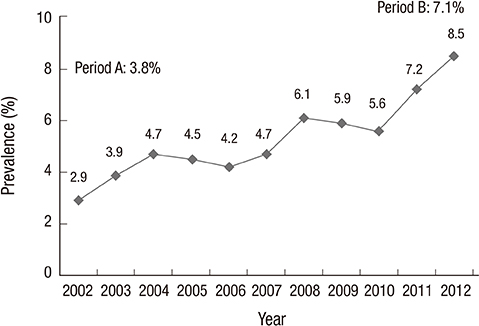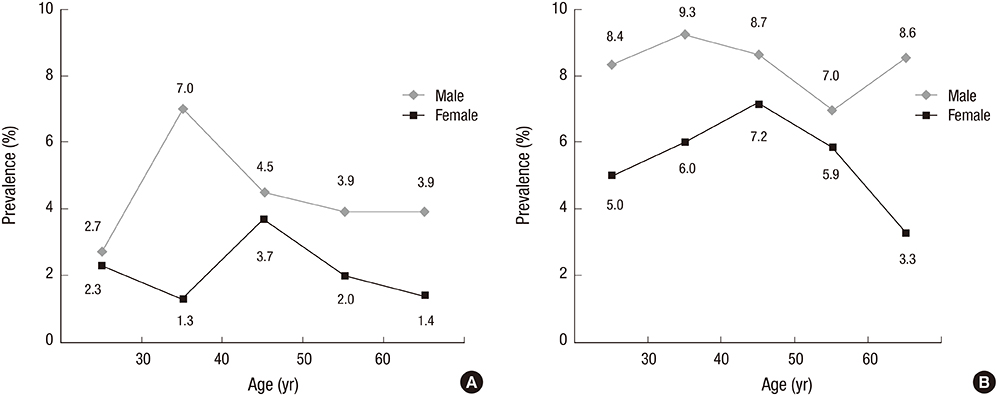Shifting Prevalence of Gallbladder Polyps in Korea
- Affiliations
-
- 1Division of Gastroenterology and Hepatology, Department of Internal Medicine, Keimyung University School of Medicine, Daegu, Korea. seenae99@dsmc.or.kr
- KMID: 1794603
- DOI: http://doi.org/10.3346/jkms.2014.29.9.1247
Abstract
- Only a few studies have evaluated the population-adjusted prevalence of gallbladder polyps (GBP). This study aimed to evaluate the changes in GBP prevalence and risk factors at a single health screening center in Korea from 2002 to 2012. Of 48,591 adults who underwent health screening between 2002 and 2012, 14,250 age- and gender-matched subjects were randomly selected to evaluate prevalence. Risk factors were analyzed between the GBP-positive and GBP-negative groups during 2002-2004 (Period A) and 2010-2012 (Period B). The annual prevalence of GBP over the 11-yr period was 5.4%. Annual prevalence increased from 3.8% in Period A to 7.1% in Period B. Male gender and obesity were independent risk factors for GBP in both periods. Hepatitis B virus surface antigen (HBsAg) positivity was a risk factor for GBP in Period A but not in Period B. The risk factors for GBP changed from HBsAg positivity to lipid profile abnormalities. Other variables including age, hypertension, diabetes, impaired fasting glucose, chronic hepatitis C virus infection, and liver function tests did not correlate with GBP. In conclusion, GBP prevalence is increasing and risk factors for GBP have changed in Korea. More attention should be paid to this issue in the future.
Keyword
MeSH Terms
Figure
Cited by 4 articles
-
Prevalence and Risk Factors of Gallbladder Polypoid Lesions in a Healthy Population
Yoo Shin Choi, Jae Hyuk Do, Suk Won Seo, Seung Eun Lee, Hyoung-Chul Oh, Yun Joo Min, Hyun Kang
Yonsei Med J. 2016;57(6):1370-1375. doi: 10.3349/ymj.2016.57.6.1370.Risk Factors of Gallbladder Polyp
Woo Hyun Paik
Korean J Gastroenterol. 2015;66(5):249-250. doi: 10.4166/kjg.2015.66.5.249.Gallstone, cholecystectomy and risk of gastric cancer
Sung Hwa Kang, Young Hoon Kim, Young Hoon Roh, Kwan Woo Kim, Chan Joong Choi, Min Chan Kim, Su Jin Kim, Hee Jin Kwon, Jin Han Cho, Jin Seok Jang, Jong Hun Lee
Ann Hepatobiliary Pancreat Surg. 2017;21(3):131-137. doi: 10.14701/ahbps.2017.21.3.131.Chronological trends in patients undergoing cholecystectomy in Korea: a nationwide health insurance claims study
Chul Hyo Jeon, Jinwook Hong, Jaehun Jung, Jong Youn Moon, Ho Seok Seo
Ann Surg Treat Res. 2022;102(4):205-213. doi: 10.4174/astr.2022.102.4.205.
Reference
-
1. Segawa K, Arisawa T, Niwa Y, Suzuki T, Tsukamoto Y, Goto H, Hamajima E, Shimodaira M, Ohmiya N. Prevalence of gallbladder polyps among apparently healthy Japanese: ultrasonographic study. Am J Gastroenterol. 1992; 87:630–633.2. Christensen AH, Ishak KG. Benign tumors and pseudotumors of the gallbladder: report of 180 cases. Arch Pathol. 1970; 90:423–432.3. Lee KF, Wong J, Li JC, Lai PB. Polypoid lesions of the gallbladder. Am J Surg. 2004; 188:186–190.4. Misra MC, Guleria S. Management of cancer gallbladder found as a surprise on a resected gallbladder specimen. J Surg Oncol. 2006; 93:690–698.5. Myers RP, Shaffer EA, Beck PL. Gallbladder polyps: epidemiology, natural history and management. Can J Gastroenterol. 2002; 16:187–194.6. Kwon W, Jang JY, Lee SE, Hwang DW, Kim SW. Clinicopathologic features of polypoid lesions of the gallbladder and risk factors of gallbladder cancer. J Korean Med Sci. 2009; 24:481–487.7. Park JK, Yoon YB, Kim YT, Ryu JK, Yoon WJ, Lee SH, Yu SJ, Kang HY, Lee JY, Park MJ. Management strategies for gallbladder polyps: is it possible to predict malignant gallbladder polyps? Gut Liver. 2008; 2:88–94.8. Park EJ, Lee HS, Lee SH, Chun HJ, Kim SY, Choi YK, Ryu HJ, Shim KW. Association between metabolic syndrome and gallbladder polyps in healthy Korean adults. J Korean Med Sci. 2013; 28:876–880.9. Korea National Statistical Office. Korean Statistical System 2010. Daejeon: Korea National Statistical Office;2010.10. Collett JA, Allan RB, Chisholm RJ, Wilson IR, Burt MJ, Chapman BA. Gallbladder polyps: prospective study. J Ultrasound Med. 1998; 17:207–211.11. WHO Expert Consultation. Appropriate body-mass index for Asian populations and its implications for policy and intervention strategies. Lancet. 2004; 363:157–163.12. Chobanian AV, Bakris GL, Black HR, Cushman WC, Green LA, Izzo JL Jr, Jones DW, Materson BJ, Oparil S, Wright JT, et al. The Seventh Report of the Joint National Committee on Prevention, Detection, Evaluation, and Treatment of High Blood Pressure: the JNC 7 report. JAMA. 2003; 289:2560–2572.13. Basevi V, Di Mario S, Morciano C, Nonino F, Magrini N. Comment on: American Diabetes Association: standards of medical care in diabetes 2011: Diabetes Care 2011;34(Suppl. 1):S11-S61. Diabetes Care. 2011; 34:e53.14. Aldouri AQ, Malik HZ, Waytt J, Khan S, Ranganathan K, Kummaraganti S, Hamilton W, Dexter S, Menon K, Lodge JP, et al. The risk of gallbladder cancer from polyps in a large multiethnic series. Eur J Surg Oncol. 2009; 35:48–51.15. Kratzer W, Haenle MM, Voegtle A, Mason RA, Akinli AS, Hirschbuehl K, Schuler A, Kaechele V. Roemerstein Study Group. Ultrasonographically detected gallbladder polyps: a reason for concern? a seven-year follow-up study. BMC Gastroenterol. 2008; 8:41.16. Lin WR, Lin DY, Tai DI, Hsieh SY, Lin CY, Sheen IS, Chiu CT. Prevalence of and risk factors for gallbladder polyps detected by ultrasonography among healthy Chinese: analysis of 34 669 cases. J Gastroenterol Hepatol. 2008; 23:965–969.17. Kim SY, Lee HS, Lee YS, Chung KW, Jang BK, Chung WJ, Park KS, Cho KB, Hwang JS. Prevalence and risk factors of gallbladder polyp in adults living in Daegu and Gyeongbuk provinces. Korean J Gastroenterol. 2006; 48:344–350.18. Hayashi Y, Liu JH, Moriguchi H, Takenawa H, Tazawa J, Nakayama E, Marumo F, Sato C. Prevalence of polypoid lesions of the gallbladder in urban and rural areas of Japan: comparison between 1988 and 1993. J Clin Gastroenterol. 1996; 23:158–159.19. Lee SB, Kang HC, Shin YT, Lee JH, Choi SI, Kim CO, Whang HJ. Prevalence of gallbladder polyp in adults in Korea. Korean J Fam Med. 2009; 30:39–45.20. Rhee SY, Park SW, Kim DJ, Woo J. Gender disparity in the secular trends for obesity prevalence in Korea: analyses based on the KNHANES 1998-2009. Korean J Intern Med. 2013; 28:29–34.21. Chen CY, Lu CL, Chang FY, Lee SD. Risk factors for gallbladder polyps in the Chinese population. Am J Gastroenterol. 1997; 92:2066–2068.22. Lim SH, Kim DH, Park MJ, Kim YS, Kim CH, Yim JY, Cho KR, Kim SS, Choi SH, Kim N, et al. Is metabolic syndrome one of the risk factors for gallbladder polyps found by ultrasonography during health screening? Gut Liver. 2007; 1:138–144.23. Yeo Y, Gwack J, Kang S, Koo B, Jung SJ, Dhamala P, Ko KP, Lim YK, Yoo KY. Viral hepatitis and liver cancer in Korea: an epidemiological perspective. Asian Pac J Cancer Prev. 2013; 14:6227–6231.24. Kim H, Shin AR, Chung HH, Kim MK, Lee JS, Shim JJ, Kim BH. Recent trends in hepatitis B virus infection in the general Korean population. Korean J Intern Med. 2013; 28:413–419.25. Park B, Choi KS, Lee HY, Jun JK, Park EC. Socioeconomic inequalities in completion of hepatitis B vaccine series among Korean women: results from a nationwide interview survey. Vaccine. 2012; 30:5844–5848.26. Khairy GA, Guraya SY, Murshid KR. Cholesterolosis. Incidence, correlation with serum cholesterol level and the role of laparoscopic cholecystectomy. Saudi Med J. 2004; 25:1226–1228.27. Sandri L, Colecchia A, Larocca A, Vestito A, Capodicasa S, Azzaroli F, Mazzella G, Mwangemi C, Roda E, Festi D. Gallbladder cholesterol polyps and cholesterolosis. Minerva Gastroenterol Dietol. 2003; 49:217–224.28. Ivanchenkova RA, Sviridov AV, Ozerova IN, Perova NV, Grachev SV. High-density lipoproteins in cholesterosis of the gall bladder. Klin Med (Mosk). 2000; 78:27–31.29. Lee HS, Duffey KJ, Popkin BM. South Korea's entry to the global food economy: shifts in consumption of food between 1998 and 2009. Asia Pac J Clin Nutr. 2012; 21:618–629.30. Hong KS, Bang OY, Kang DW, Yu KH, Bae HJ, Lee JS, Heo JH, Kwon SU, Oh CW, Lee BC, et al. Stroke statistics in Korea: part I. epidemiology and risk factors: a report from the korean stroke society and clinical research center for stroke. J Stroke. 2013; 15:2–20.31. Vijan S. Type 2 diabetes. Ann Intern Med. 2010; 152:ITC31–ITC15.
- Full Text Links
- Actions
-
Cited
- CITED
-
- Close
- Share
- Similar articles
-
- Gallbladder polyps: evolving approach to the diagnosis and management
- Recent Updates on Diagnosis, Treatment, and Follow-up of Gallbladder Polyps
- Practical Guidelines for Management of Gallbladder Polyps
- Association of Gallbladder Polyp with the Risk of Colorectal Adenoma
- Disparity between ultrasonographic and pathologic findings of laparoscopically removed gallbladder polyps



